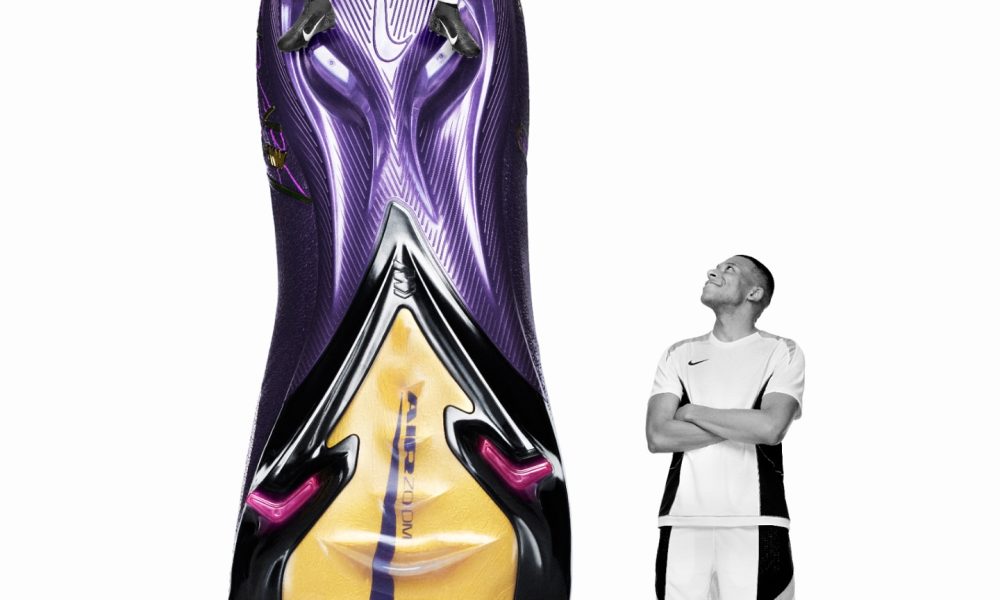Sports
The competitive esports physiological, affective, and video dataset
Abstract National Science Centre in Poland supported preparing this article with a research grant (UMO-2020/39/B/HS6/00685) and a scholarship awarded to M.B. by the Foundation for Polish Science (FNP). The funder had no role in study design, data collection, analysis, publishing decisions, or manuscript preparation. The project was conducted in AMU Psychophysiology Lab: Positive Gaming & […]


Abstract
Background & Summary
PubMed
Google Scholar
MAPI Research Institute. Generalized Anxiety Disorder – 7 (GAD-7). Available at: https://eprovide.mapi-trust.org/instruments/generalized-anxiety-disorder-7 (accessed July 2023).Dweck, C. S. Mindset: The New Psychology of Success. Random House (2006).
-
1)
Crum, A. J., Salovey, P. & Achor, S. Rethinking stress: the role of mindsets in determining the stress response. J. Pers. Soc. Psychol. 104, 716 (2013).
- 2)
- 3)
-
4)
Bailey, H. Open Broadcasting Software. Retrieved from https://obsproject.com/ (2018).
Received:
Methods
MATH
Google Scholar
Participants
De France, K. & Hollenstein, T. Assessing emotion regulation repertoires: The regulation of emotion systems survey. Pers. Individ. Differ. 119, 204–215 (2017).
Ethics Information
The physiological and behavioral data, in a CSV format, constitute 366 GB of space32. The files are grouped into eight subcomponents with a maximum size of 50 GB due to OSF storage restrictions. The component’s name indicates for which study stage (S1 vs S3) and participants and which person they refer to. For instance, the name ‘Physio_S3_225_300’ indicates that the component included psychophysiological and behavioral data from Stage 3 for participants from 225 to 300. The component contains a set of CSV files for particular subjects. All psychophysiological and behavioral signals recorded during the experiment for each individual are available in a single CSV datafile named “S < stage_id > _P < participant_id >,” where “S” stands for study stage, “P” for participants, e.g., S1_P10.csv, or S3_P224.csv. The “< particpant_id >” is a natural number identifying a participant.
Procedure
Article
PubMed
PubMed Central
Google Scholar

Stage 1
Internal/external validity: our study offered a unique blend of internal and external validity through the use of controlled experiments paired with real-world outcomes. It included a thorough evaluation of affective and physiological dynamics and implemented a robust, theory-driven intervention.
Zhang, Z. et al. Multimodal spontaneous emotion corpus for human behavior analysis. In IEEE Conf. Comput. Vision Pattern Recognit. 3438–3446 (2016).Article
PubMed
Google Scholar
Stage 2
Article
MATH
Google Scholar
Article
PubMed
Google Scholar
Stage 3
Epel, E. S. et al. More than a feeling: A unified view of stress measurement for population science. Front. Neuroendocrinol. 49, 146–169 (2018).Kroenke, K., Spitzer, R. L. & Williams, J. B. The Patient Health Questionnaire-2: validity of a two-item depression screener. Med. Care 41, 1284–1292 (2003).Some information about our study is detailed in the published registered report6 – which presents hypothesis testing related to the effects of the Synergistic Mindsets Intervention – including a comprehensive description of the sampling procedures, study procedure, questionnaires, and physiological data. In this paper, we provide additional details on open-text responses, video recordings, and behavioral data. Furthermore, we include new information regarding data quality and present how the measures changed over the course of laboratory visits. Finally, to enhance the usability of the CEPAV dataset, we standardized and merged the physiological and behavioral data collected from three different devices (each with distinct data formats and sampling rates) and uploaded the resulting user-friendly files instead of the raw data.
Measures
Questionnaires
Article
PubMed
MATH
Google Scholar
Open-Text answers
You can also search for this author in
PubMed Google Scholar
Other self-reports
Demographics
Article
CAS
PubMed
PubMed Central
MATH
Google Scholar
Performance
Brytek-Matera, A. & Kozieł, A. The body self-awareness among women practicing fitness: a preliminary study. Pol. Psychol. Bull. 46, 104–111 (2015).
Video data
Video recordings
Crum, A. J., Akinola, M., Martin, A. & Fath, S. The role of stress mindset in shaping cognitive, emotional, and physiological responses to challenging and threatening stress. Anxiety Stress Coping 30, 379–395 (2017).
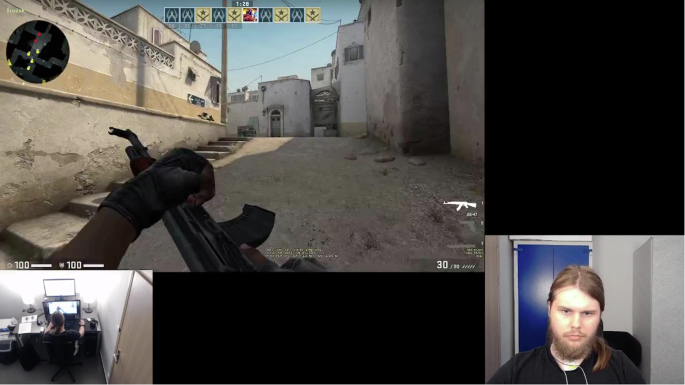
Gameplay recordings
Article
CAS
PubMed
PubMed Central
Google Scholar
Physiological measures
Impedance cardiography and electrocardiography
Article
CAS
PubMed
MATH
Google Scholar
Blood pressure
Shui, X. et al. A dataset of daily ambulatory psychological and physiological recording for emotion research. Sci. Data 8, 161 (2021).
Behavioral measures
Kroenke, K., Spitzer, R. L., Williams, J. B., Monahan, P. O. & Löwe, B. Anxiety disorders in primary care: prevalence, impairment, comorbidity, and detection. Ann. Intern. Med. 146, 317–325 (2007).
Data preprocessing
Koelstra, S. et al. Deap: A database for emotion analysis; using physiological signals. IEEE Trans. Affective Comput. 3, 18–31 (2011).Histograms Presenting Ranges of Means of Collected Signals. Panel A presents data from Stage 1; Panel presents data from Stage 3. HR – Heart rate, bpm, SBP – Systolic Pressure, mmHg; DBP – Diastolic Pressure mmHg; SV – Stroke Volume, ml; LVET – Left Ventricular Ejection Time, ms; PI- Pulse Interval, ms; MS – Maximum Slope; mmHg/s; CO – Cardiac Output; l/min; TPR – Total Peripheral Resistance Medical Unit, mmHg.min/l; TPRCGS – Total Peripheral Resistance CGS; dyn.s/cm5; wr – right wrist movement, custom units; tl – left thigh movement, custom units; tr – right thigh movement, custom units.Article
PubMed
PubMed Central
MATH
Google Scholar
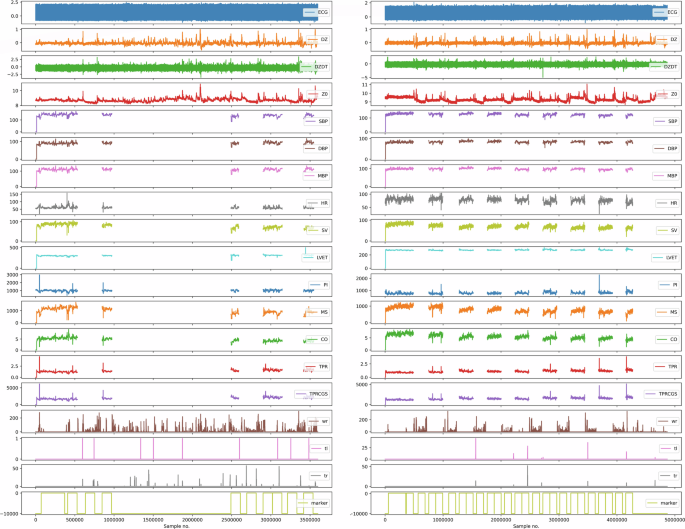
PubMed Google Scholar
Maciej Behnke, Wadim Krzyżaniak, Patrycja Chwiłkowska, Szymon Jęśko Białek, Maciej Kłoskowski, Patryk Maciejewski & Kacper Szymański
Data Records
Dataset Structure
Self-reports and metadata
Ab. Aziz, N. A. K. T. et al. Asian affective and emotional state (A2ES) dataset of ECG and PPG for affective computing research. Algorithms 16, 130 (2023).
Video data
Melhart, D., Liapis, A. & Yannakakis, G. N. The arousal video game annotation (AGAIN) dataset. IEEE Trans. Affective Comput. 13, 2171–2184 (2022).
Physiological and behavioral data
Jankowski, K. S. Is the shift in chronotype associated with an alteration in well-being? Biol. Rhythm Res. 46, 237–248 (2015).
Single physiological file structure
Technical Validation
Missing data
Questionnaires reliability
Koldijk, S., Sappelli, M., Verberne, S., Neerincx, M. A. & Kraaij, W. The swell knowledge work dataset for stress and user modeling research. In Multimodal Interaction (2014).
Physiological data – qualitative validation
Physiological data – quantitative validation
Article
MATH
Google Scholar
Yeager, D. S. et al. A synergistic mindsets intervention protects adolescents from stress. Nature 607, 512–520 (2022).Li, J. Psychometric properties of Ten-Item Personality Inventory in China. Chin. J. Health Psychol. 21, 1688–1692 (2013).
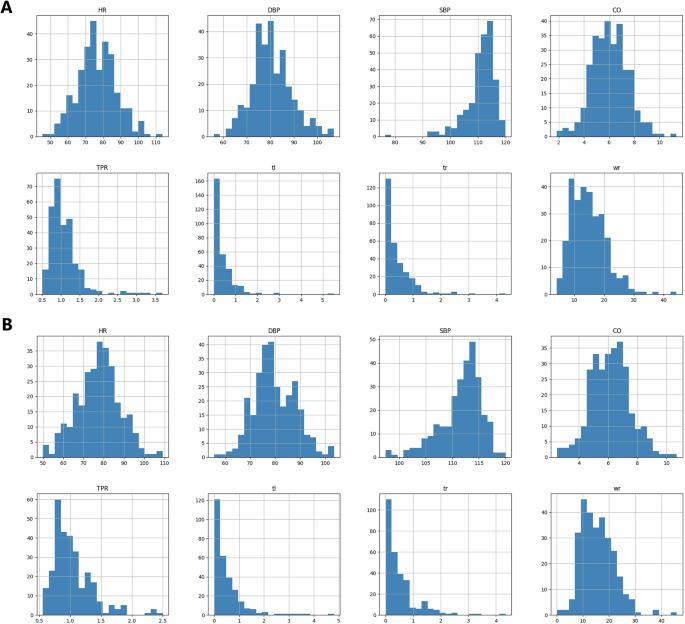
Summary of previously completed analyses
Summary of the physiological, affective, and behavioral activity during the competitive esports
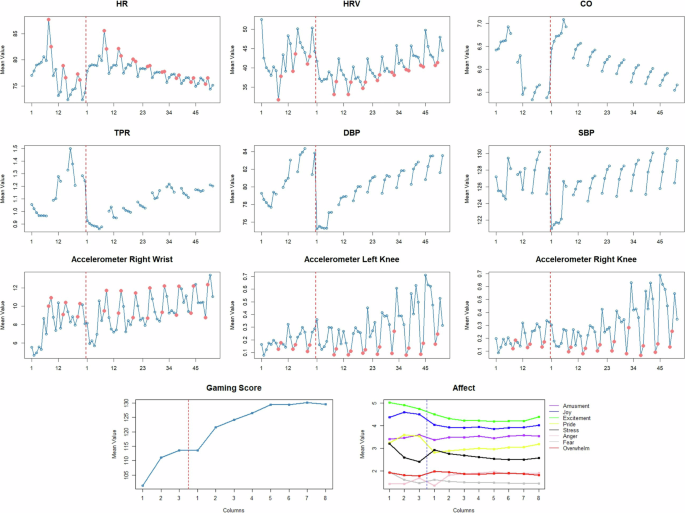
Usage Notes
PubMed
Google Scholar
Declaration of Generative AI and AI-assisted technologies in the writing process
Christy, A. G., Schlegel, R. J. & Cimpian, A. Why do people believe in a “true self”? The role of essentialist reasoning about personal identity and the self. J. Pers. Soc. Psychol. 117, 386–416 (2019).
References
- Article
PubMed
Google Scholar - Article
PubMed
Google Scholar - Department of Psychology, Stanford University, Stanford, USAGosling, S. D., Rentfrow, P. J. & Swann, W. B. Jr. A very brief measure of the Big-Five personality domains. J. Res. Pers. 37, 504–528 (2003).
- Robins, R. W., Hendin, H. M. & Trzesniewski, K. H. Measuring global self-esteem: Construct validation of a single-item measure and the Rosenberg Self-Esteem Scale. Pers. Soc. Psychol. Bull. 27, 151–161 (2001).Moore, L. J., Vine, S. J., Wilson, M. R. & Freeman, P. The effect of challenge and threat states on performance: An examination of potential mechanisms. Psychophysiology 49, 1417–1425 (2012).
- Kroenke, K., Spitzer, R. L. & Williams, J. B. W. The PHQ-9: Validity of a brief depression severity measure. J. Gen. Intern. Med. 16, 606–613 (2001).Markova, V., Ganchev, T. & Kalinkov, K. Clas: A database for cognitive load, affect, and stress recognition. In Biomed. Innov. Appl. (2019).
- Article
Google Scholar
Other psychophysiological datasets related to affective manipulations exist (see Tables 1–3), but these datasets are usually related to one of the data types included in CEPAV. We reviewed existing openly available datasets of physiological responses to affective manipulations. Compared to the CEPAV strengths, we found that only four databases included physiological, behavioral, and video data along with individual differences measures8,9,10,11. Seven databases included data collected on multiple occasions10,12,13,14,15,16,17. Only one database included more participants than the CEPAV18 dataset. Finally, we found five datasets that included gaming, including simple labyrinth games9, racing games19,20 shooter games platform games19, FIFA21, and League of Legends16. Only one dataset included data on participants’ performance16, while other datasets used gaming as a situational context for the study. - Crucianelli, L., Enmalm, A. & Ehrsson, H. H. Interoception as independent cardiac, thermosensory, nociceptive, and affective touch perceptual submodalities. Biol. Psychol. 172, 108355 (2022).Hsu, Y. L., Wang, J. S., Chiang, W. C. & Hung, C. H. Automatic ECG-based emotion recognition in music listening. IEEE Trans. Affective Comput. 11, 85–99 (2017).
- De France, K. & Hollenstein, T. Emotion regulation and relations to well-being across the lifespan. Dev. Psychol. 55, 1768–1778 (2019).
- The upper-body recordings in an MP4 format, full HD resolution (1920 × 1080) constitute 820 GB of space31. The files are grouped into 19 components with a maximum size of 50 GB due to OSF storage restrictions. The component’s name indicates for which study stage (S1 vs S3) and participants and which person they refer to. For instance, the name ‘Video_S3_255_280’ indicates that the component included a video record from Stage 3 for participants from 255 to 280. To ease the video data analysis, we included the time intervals for each experimental epoch in the “CEPAV_data/video_timing” sheet24 (e.g., for Stage 1 for Participant 8, the baseline starts at 1:17 minutes of video).Article
CAS
PubMed
PubMed Central
Google Scholar - Hughes, B. M., Lü, W. & Howard, S. Cardiovascular stress-response adaptation: Conceptual basis, empirical findings, and implications for disease processes. Int. J. Psychophysiol. 131, 4–12 (2018).The CEPAV dataset is publicly available at the Open Science Framework (OSF) repository1.
- Article
PubMed
Google Scholar
You can also search for this author in
PubMed Google Scholar - Subramanian, R. et al. ASCERTAIN: Emotion and personality recognition using commercial sensors. IEEE Trans. Affective Comput. 9, 147–160 (2016).We evaluated the quality of the signal with the Signal to Noise Ratio (SNR). In order to calculate SNR across the diverse physiological signals, we used an algorithm based on the autocorrelation function of the signal, using the second-order polynomial for fitting the autocorrelation function curve34. We used this approach in our previous project18. The script we used for calculating SNR is available in the Code Component30 and project’s GitHub repository (https://github.com/psychosensing/CEPAV). The SNR coefficients for all channels for Stages 1 and 3 are available in the “CEPAV_data/SNR” sheet24.
- Article
MATH
Google Scholar
Soleymani, M., Lichtenauer, J., Pun, T. & Pantic, M. A multimodal database for affect recognition and implicit tagging. IEEE Trans. Affective Comput. 3, 42–55 (2011). - Abbey, J. D. & Meloy, M. G. Attention bydesign: Using attention checks to detect inattentive respondentsand improve data quality. J. Oper. Manag. 53, 63–70 (2017).
- Article
CAS
PubMed
PubMed Central
Google Scholar
Article
PubMed
Google Scholar - Article
CAS
PubMed
PubMed Central
Google Scholar - Schleider, J. L., Mullarkey, M. C. & Weisz, J. R. Virtual reality and web-based growth mindset interventions for adolescent depression: Protocol for a three-arm randomized trial. JMIR Res. Protoc. 8, e13368 (2019).Wylie, M. S. et al. Momentary emotion regulation strategy use and success: Testing the influences of emotion intensity and habitual strategy use. Emotion 22, 83–95 (2022).
- Given the expense associated with assembling comprehensive multimodal datasets, there is growing interest in reusing existing datasets, a practice that remains underutilized due to the scarcity of openly shared raw data. For data reuse, it is particularly important to share the raw data rather than the pre-processed data used for analysis, as raw data are needed in order to fully replicate analyses and harness the full potential of the data. This is particularly critical in fields like affective computing, where developing algorithms capable of understanding and adapting to human emotions relies on access to diverse and detailed descriptors of emotional responses. Such openness and transparency not only enhance the potential for interdisciplinary collaboration but also significantly enrich the resources available for affective science. By providing raw, unprocessed data, researchers enable more nuanced analysis, fostering advancements in understanding the complexities of affective phenomena.Ware, J. E. Jr. & Sherbourne, C. D. The MOS 36-item short-form health survey (SF-36): I. Conceptual framework and item selection. Med. Care 30, 473–483 (1992).
- You can also search for this author in
PubMed Google ScholarCorrespondence to
Maciej Behnke. - Behnke, M. et al. CEPAV Dataset, Raw_Physio Component. Open Science Framework https://doi.org/10.17605/OSF.IO/HKDUY (2024).Physiological and behavioral data were exported from the acquisition formats by the first author (MB). We used different acquisition software; therefore, the exported data had to be integrated into a common format. The exported TXT and CSV files were preprocessed using Python28,29 scientific libraries (e.g., pandas 2.2.2, numpy 1.26.4; see Code Availability, for detailed information). In addition to scripts for processing the typical data, we also added scripts for handling problematic cases and exceptions.
- In our initial publication, we tested the effects of the Synergistic Mindsets Intervention (SMI) compared to a control intervention6. The SMI was positively received, leading participants to adopt more advantageous stress mindsets, more favourable appraisals of the esports tournament, and an increased application of reappraisal strategies for emotion regulation. Despite these positive outcomes, the high-stakes nature of the esports competition was perceived as an enjoyable challenge rather than a negative stressor, reducing the potential for the SMI to significantly influence affective and physiological reactions. The absence of a negative physiological stress response meant there was very little for the intervention to modulate. Consequently, no significant changes were noted in affective responses or gaming performance due to the intervention. Access to the research code, dataset, and findings can be found elsewhere6.
- We converted the raw acquired data (obtained with proprietary acquisition software) into a consistent format and saved it in CSV files. All signals were resampled to 1 kHz, using the previous neighbor interpolation method. Signals from different devices were time-synchronized using synchronization markers generated by VU-AMS and Finometer devices during experiments. We marked the baselines, matches, and recoveries within the files. Finally, data across studies were exported to normalized form, consisting of a header, predefined file structure, and standardized subject naming convention. The description of labels used for tagging specific epochs is available in the “CEPAV_data” file24, the “epoch_name” sheet.
- You can also search for this author in
PubMed Google Scholar - Roksa, J. & Kinsley, P. The role of family support in facilitating academic success of low-income students. Res. High. Educ. 60, 415–436 (2019).
- Esports refers to competitive video gaming where individuals compete against each other in organized tournaments for prize money. Here, we present the Competitive Esports Physiological, Affective, and Video (CEPAV) dataset, in which 300 male Counter Strike: Global Offensive gamers participated in a study aimed at optimizing affect during esports tournament1. The CEPAV dataset includes (1) physiological data, capturing the player’s cardiovascular responses from before, during, and after over 3000 CS: GO matches; (2) self-reported affective data, detailing the affective states experienced before gameplay; and (3) video data, providing a visual record of 552 in-laboratory gaming sessions. We also collected (affect-related) individual differences measures (e.g., well-being, ill-being) across six weeks in three waves. The self-reported affective data also includes gamers’ natural language descriptions of gaming affective situations. The CEPAV dataset provides a comprehensive resource for researchers and analysts seeking to understand the complex interplay of physiological, affective, and behavioral factors in esports and other performance contexts.
- Saganowski, S. et al. Emognition dataset: Emotion recognition with self-reports, facial expressions, and physiology using wearables. Sci. Data 9, 158 (2022).Moore, L. J., Vine, S. J., Wilson, M. R. & Freeman, P. Reappraising threat: How to optimize performance under pressure. J. Sport Exerc. Psychol. 37, 339–343 (2015).
- MAPI Research Institute. Patient Health Questionnaire (PHQ). Available at: https://eprovide.mapi-trust.org/instruments/patient-health-questionnaire (accessed July 2023).van Lien, R., Neijts, M., Willemsen, G. & de Geus, E. J. Ambulatory measurement of the ECG T‐wave amplitude. Psychophysiology 52, 225–237 (2015).
- Wang, Z. et al. Reliability and validity of the Chinese version of Beck Depression Inventory-II among depression patients. Chin. Ment. Health J. 25, 476–480 (2011).
- MATH
Google Scholar
Visualization Single Physiological File Structure for Stage 1 (left panel) and 3 (right panel). ECG- electrocardiogram, mV; Z0 – Average thorax impedance, ohm; dZ – Change in impedance due to respiration and heartbeat, ohm; dZ/dt – Impedance CardioGram, ohm/s; SBP – Systolic Pressure, mmHg; DBP – Diastolic Pressure, mmHg; MAP- Mean Pressure, mmHg; HR – Heart rate, bpm; SV – Stroke Volume, ml; LVET – Left Ventricular Ejection Time, ms; PI- Pulse Interval, ms; MS – Maximum Slope; mmHg/s; CO – Cardiac Output; l/min; TPR – Total Peripheral Resistance Medical Unit, mmHg.min/l; TPRCGS – Total Peripheral Resistance CGS; dyn.s/cm5; wr – right wrist movement, custom units; tl – left thigh movement, custom units; tr – right thigh movement, custom units. - Ringeval, F., Sonderegger, A., Sauer, J. & Lalanne, D. Introducing the RECOLA multimodal corpus of remote collaborative and affective interactions. In Face Gesture Recognit. (2013).
- Article
PubMed
PubMed Central
MATH
Google Scholar - Meade, A. W. & Craig, S. B. Identifying carelessresponses in survey data. Psychol. Methods 17, 437–455 (2012).
- Article
CAS
PubMed
MATH
Google Scholar
Shifts in Mean Levels of Affective Measures. Red line separates Stage 1 and Stage 3 laboratory visits. HR – Heart rate, bpm, SBP – Systolic Pressure, mmHg; DBP – Diastolic Pressure mmHg; CO – Cardiac Output; l/min; TPR – Total Peripheral Resistance Medical Unit, mmHg.min/l. - O’Brien, S. T. et al. SEMA3: A free smartphone platform for daily life surveys. Behav. Res. Methods 1–16 (2024).Carstensen, L. L., Shavit, Y. Z. & Barnes, J. T. Age advantages in emotional experience persist even under threat from the COVID-19 pandemic. Psychol. Sci. 31, 1374–1385 (2020).
- Article
Google Scholar
Beili, Z. Introduction to the POMS scale and the short-form Chinese norm. J. Tianjin Sports Inst. 35–37 (1995). - Article
PubMed
Google Scholar
Article
Google Scholar - Raheel, A., Majid, M. & Anwar, S. M. DEAR-MULSEMEDIA: Dataset for emotion analysis and recognition in response to multiple sensorial media. Inf. Fusion 65, 37–49 (2021).
- Article
MATH
Google Scholar
Article
Google Scholar - During the preparation of this work, the authors used Grammarly and ChatGPT4.0 to improve the readability and language. After using this tool/service, the authors reviewed and edited the content as needed and take full responsibility for the publication’s content.Costa, P. & McCrae, R. Revised NEO Personality Inventory (NEO-PI-R) and NEO Five Factor Inventory (NEO-FFI). Professional manual. Psychological Assessment Resources (1992).
- Article
PubMed
MATH
Google Scholar
Moore, L. J., Wilson, M. R., Vine, S. J., Coussens, A. H. & Freeman, P. Champ or chump?: Challenge and threat states during pressurized competition. J. Sport Exerc. Psychol. 35, 551–562 (2013). - DOI: https://doi.org/10.1038/s41597-024-04364-z
- Behnke, M. et al. CEPAV Dataset, Videos Component. Open Science Framework https://doi.org/10.17605/OSF.IO/QKD5B (2024).
- Article
PubMed
MATH
Google Scholar
Fredrickson, B. L. Positive emotions broaden and build. Adv. Exp. Soc. Psychol. 47, 1–53 (2013). - You can also search for this author in
PubMed Google ScholarCudo, A., Montag, C. & Pontes, H. M. Psychometric assessment and gender invariance of the Polish version of the Gaming Disorder Test. Int. J. Ment. Health Addict. 1–24 (2022). - Schleider, J. L. et al. Acceptability and utility of an open-access, online single-session intervention platform for adolescent mental health. JMIR Ment. Health 7, e20513 (2020).
- Smerdov, A. et al. Collection and validation of psychophysiological data from professional and amateur players: A multimodal esports dataset. arXiv preprint arXiv:2011.00958 (2020).
- Kutt, K. et al. BIRAFFE2: A multimodal dataset for emotion-based personalization in rich affective game environments. Sci. Data 9, 274 (2022).Open Access This article is licensed under a Creative Commons Attribution 4.0 International License, which permits use, sharing, adaptation, distribution and reproduction in any medium or format, as long as you give appropriate credit to the original author(s) and the source, provide a link to the Creative Commons licence, and indicate if changes were made. The images or other third party material in this article are included in the article’s Creative Commons licence, unless indicated otherwise in a credit line to the material. If material is not included in the article’s Creative Commons licence and your intended use is not permitted by statutory regulation or exceeds the permitted use, you will need to obtain permission directly from the copyright holder. To view a copy of this licence, visit http://creativecommons.org/licenses/by/4.0/.
- Article
PubMed
MATH
Google Scholar
For open-text responses, we initially reviewed and corrected any typographical and spelling mistakes. Subsequently, we translated these responses into English using DeepL Translator (DeepL GmbH, Cologne, Germany). Two judges (KS, MB, MK, or SJB) then compared the English translations to the original Polish texts, making adjustments for any clear translation errors. Three judges deliberated on more complex issues and resolved them through consensus. - Article
CAS
PubMed
PubMed Central
MATH
Google Scholar
You can also search for this author in
PubMed Google Scholar - Article
PubMed
PubMed Central
Google Scholar
Thong, J. T. L., Sim, K. S. & Phang, J. C. H. Single‐image signal‐to‐noise ratio estimation. Scanning 23, 328–336 (2001). - Zamariola, G. et al. Relationship between interoceptive accuracy, interoceptive sensibility, and alexithymia. Pers. Individ. Differ. 125, 14–20 (2018).You can also search for this author in
PubMed Google Scholar - We collected the number of kills, kills’ assists, and deaths and the match scores as determined by the Counter-Strike: Global Offensive scoring system, which factors in the difficulty of the weapon used and the points earned for each enemy bot eliminated. A higher score reflects superior performance. Gamers’ tournament performance was primarily evaluated based on their total score, making it the main performance index. However, other metrics—kills, assists, and deaths—can provide insight into the participant’s strategy. For instance, a high total score paired with a high number of deaths may indicate a risk-taking approach. Analyzing which strategies proved optimal or suited individual gamers could be valuable for esports coaches, helping them tailor training and game plans effectively. In Stage 2, participants were asked to log their daily match scores, simulating the conditions of the upcoming tournament.Download references
- However, the dataset comes with certain limitations. First, this dataset cannot be employed to investigate differences between sexes, ethnicities, or between the group ages, as all participants were male Caucasian young adults. Second, our investigation was confined to affective reactions within a single esports (Counter Strike: Global Offensive) context. Third, as noted in the missing data section, the dataset lacks some data due to technical constraints (e.g., ICG missing due to electrode detachment), lack of consent to share data, and human errors (e.g., not starting data collection for accelerometers). Lastly, the dataset represents a secondary use of data initially collected for a previously published independent study.Accepted:
- We present questionnaires, open-text, other self-reported data, and auxiliary information about the participants in the “CEPAV_data” spreadsheet24. The file includes participants’ ID, sex, age, height, weight, experimental conditions, and questionnaire responses (the “self_reports” sheet). To make it easier to use the database, we also included averages for physiological and behavioral data from selected moments of the study in the file, which were used for the Summary of the Physiological, Affective, and Behavioral Activity During the Competitive Esports (Technical Validation section) and presented in Fig. 5 (the “physio_behav” sheet)24.Uusberg, A. et al. Appraisal shifts during reappraisal. Emotion 23, 1985–2001 (2023).
- Participant movement was non-invasively tracked using three tri-axial accelerometers (model wGT3X-BT, Actigraph, USA), placed on the thighs (thigh left and thigh right; TL & TR) next to the knee and the right wrist (WR), allowing for the continuous observation of physical activity and gestures during gameplay. All accelerometers were initialized before the participant’s arrival to collect raw acceleration data at 30 Hz with the same start time using ActiLife software (version 6.13.4). We used the measure of the vector magnitude for the given accelerometer for each 1-second interval extracted with the ActiLife software.Behnke, M., Krzyżaniak, W., Nowak, J. et al. The competitive esports physiological, affective, and video dataset.
Sci Data 12, 56 (2025). https://doi.org/10.1038/s41597-024-04364-z - Article
PubMed
MATH
Google Scholar - Park, C. Y. et al. K-EmoCon: A multimodal sensor dataset for continuous emotion recognition in naturalistic conversations. Sci. Data 7, 293 (2020).Cohn, M. A., Fredrickson, B. L., Brown, S. L., Mikels, J. A. & Conway, A. M. Happiness unpacked: Positive emotions increase life satisfaction by building resilience. Emotion 9, 361–368 (2009).
- Prospective Studies Collaboration. Age-specific relevance of usual blood pressure to vascular mortality: A meta-analysis of individual data for one million adults in 61 prospective studies. The Lancet 360, 1903–1913 (2002).Gualano, M. R., Lo Moro, G., Voglino, G., Bert, F. & Siliquini, R. Effects of Covid-19 lockdown on mental health and sleep disturbances in Italy. Int. J. Environ. Res. Public Health 17, 4779 (2020).
- Katsigiannis, S. & Ramzan, N. DREAMER: A database for emotion recognition through EEG and ECG signals from wireless low-cost off-the-shelf devices. IEEE J. Biomed. Health Inform. 22, 98–107 (2017).Goldberg, D. P. & Hillier, V. F. A scaled version of the general health questionnaire. Psychol. Med. 9, 139–145 (1979).
- Human-Technology Interaction, Eindhoven University of Technology, Eindhoven, The NetherlandsLawes, M., Hetschko, C., Schöb, R., Stephan, G. & Eid, M. The impact of unemployment on cognitive, affective, and eudaimonic well-being facets: Investigating immediate effects and short-term adaptation. J. Pers. Soc. Psychol. 124, 659–681 (2023).
- Participants’ upper bodies were continuously captured on video using an HD camera positioned in between the monitors, utilizing the Open Broadcaster Software25. The camera was set approximately 65 cm away from the participants’ heads, with a recording at 30 FPS. We also captured the back view of the experimental view with the camera near the ceiling (Fig. 2). These recordings were primarily used to monitor the study’s progress and ensure participant safety.Medland, H., De France, K., Hollenstein, T., Mussoff, D. & Koval, P. Regulating emotion systems in everyday life: Reliability and validity of the RESS-EMA scale. Eur. J. Psychol. Assess. 36, 437 (2020).
- Article
Google Scholar
Affective science is an interdisciplinary field that draws upon methods and findings from psychology, cognitive science, neuroscience, computer science, biology, and other related fields to understand the complexities of affective phenomena and to determine how they influence human behavior. Multimodal data are needed to thoroughly investigate affective phenomena. Different scientific backgrounds equip researchers with unique skills for data collection. For example, psychologists excel in experimental designs, computer scientists excel in data mining from digital platforms, and biomedical researchers excel in collecting biological samples. Interdisciplinary teams leverage these diverse methodologies to approach research questions by collecting comprehensive multi-modal datasets. - Diener, E., Emmons, R. A., Larsen, R. J. & Griffin, S. The Satisfaction with Life Scale. J. Pers. Assess. 49, 71–75 (1985).Article
Google Scholar - The physiological data quality was assured by following recommendations in affective science33. First, the data were collected by experimenters who completed at least 30 hours of training in psychophysiological research provided by MB. Second, prior to performing preprocessing, the first author (MB) visually inspected all physiological signals. Before inclusion in the database, MB manually double-checked all datasets for missing or corrupted data.
Reprints and permissionsPanzeri, A. et al. Factors impacting resilience as a result of exposure to COVID-19: The ecological resilience model. PLoS One 16, e0256041 (2021).
Google Scholar
Article
PubMed
PubMed Central
Google Scholar
MATH
Google Scholar
Majka, E. A., Guenther, M. F. & Raimondi, S. L. Science bootcamp goes virtual: A compressed, interdisciplinary online CURE promotes psychosocial gains in STEM transfer students. J. Microbiol. Biol. Educ. 22, 10–1128 (2021).
CAS
PubMed
MATH
Google Scholar
PubMed Google ScholarArticle
MATH
Google Scholar
MATH
Google Scholar
PubMed Google ScholarPreece, D. A. et al. The Perth Alexithymia Questionnaire-Short form (PAQ-S): A 6-item measure of alexithymia. J. Affect. Disord. 325, 493–501 (2023).
PubMed
PubMed Central
MATH
Google Scholar
Article
MATH
Google Scholar
Google Scholar
Article
PubMed
PubMed Central
Google Scholar
PubMed
PubMed Central
MATH
Google Scholar
Ranganathan, H., Chakraborty, S. & Panchanathan, S. Multimodal emotion recognition using deep learning architectures. In Winter Conf. Appl. Comput. Vision (2016).
Google Scholar
Article
CAS
PubMed
MATH
Google Scholar
PubMed
PubMed Central
MATH
Google Scholar
Article
CAS
PubMed
MATH
Google Scholar
Google Scholar
Article
MATH
Google Scholar
Google Scholar
PubMed
MATH
Google Scholar
PubMed
Google Scholar
PubMed
Google Scholar
Fingerman, K. L. et al. Living alone during COVID-19: Social contact and emotional well-being among older adults. J. Gerontol. B 76, e116–e121 (2021).
Google Scholar
Gross, J. J. & John, O. P. Individual differences in two emotion regulation processes: Implications for affect, relationships, and well-being. J. Pers. Soc. Psychol. 85, 348–362 (2003).
MATH
Google Scholar
Article
PubMed
PubMed Central
MATH
Google Scholar
PubMed
PubMed Central
Google Scholar
CAS
MATH
Google Scholar
CAS
PubMed
PubMed Central
Google Scholar
PubMed
Google Scholar
Steger, M. F., Frazier, P., Oishi, S. & Kaler, M. The meaning in life questionnaire. J. Couns. Psychol. 53, 80–93 (2015).
PubMed
PubMed Central
Google Scholar
Becerra, R., Preece, D. A. & Gross, J. J. Assessing beliefs about emotions: Development and validation of the Emotion Beliefs Questionnaire. PLoS One 15, e0231395 (2020).
PubMed
MATH
Google Scholar
The sample consisted of 300 male players of Counter-Strike: Global Offensive (CS: GO), aged between 18 and 32 years, with a mean age of 21.95 years (SD = 2.29). Competitive experience varied within the group: 200 players (67%) had no experience, 76 (25%) had competed in local tournaments, 17 (6%) had participated nationally, and six (2%) had taken part in international competitions. One participant did not disclose his competitive background. Esports provided an additional income source for 17 participants, while the rest did not earn money through gaming. On average, participants had been playing CS: GO for 9.13 years (SD = 5.22), with a mean total gameplay time of 2225.69 hours (SD = 1980.55) as recorded in their Steam Library (Valve Corp., SA). The number of participants varied across CS: GO ranks, with 9 participants ranked as Silver I, 2 as Silver III, 7 as Silver IV, 4 as Silver Elite, 4 as Silver Elite Master, 10 as Gold Nova I, 14 as Gold Nova II, 12 as Gold Nova III, 11 as Gold Nova Master, 28 as Master Guardian I, 21 as Master Guardian II, 26 as Master Guardian Elite, 27 as Distinguished Master Guardian, 29 as Legendary Eagle, 32 as Legendary Eagle Master, 19 as Supreme Master First Class, 44 as Global Elite. Details related to inclusion and exclusion criteria and the process of sample size determination are described elsewhere6.
PubMed Google Scholar
ADS
CAS
PubMed
PubMed Central
MATH
Google Scholar
Project and Match Procedures. The red frames represent a procedure for all performances (to simplify the figure, we depicted it in detail only for baseline performance), namely prematch physiology, affective experience, Counter-Strike: Global Offensive match, and recovery. Baseline and post-intervention questionnaires include negative prior mindsets, positive and negative affective experiences, affect regulation strategies, well-being, ill-being, alexithymia, and emotion belief measures. Affective self-report includes affective experience and demands and resources evaluation. Emotion recall tasks include recalling and describing situations from the tournament that elicited positive and negative affective experiences and evaluating them using affective experience, situational appraisals and affect regulation strategies measures. One month after Stage 3, participants were asked to fill in follow-up questionnaires, the same set as at baseline and post-intervention. Figure reproduced from our previous article6, used under a CC BY license.
Google Scholar
MATH
Google Scholar
The calculated SNR indicated the high quality of all collected signals35, with mean SNR ranging from 21.90 dB to 68.05 dB depending on the physiological signal and study. We identified outliers with the median absolute deviation, with a cutoff of 3, as recommended by Leys et al.36,37, resulting in 416 signals (3.94% of all calculated SNR values) identified as SNR outliers. Next, the first author (MB) visually inspected all flagged data to determine whether the signal should be deleted and classified as an artifact, resulting in 17 signals being identified as artifacts. Outlying signals are marked with yellow color in the “SNR” sheet with additional comments from the first author on reasons that potentially influenced the outlying values (e.g., disconnecting ECG and ICG electrodes after the study while the signals were still being recorded).
PubMed Google ScholarTomaka, J., Blascovich, J., Kelsey, R. M. & Leitten, C. L. Subjective, physiological, and behavioral effects of threat and challenge appraisal. J. Pers. Soc. Psychol. 65, 248–260 (1993).
PubMed
PubMed Central
MATH
Google Scholar
PubMed
PubMed Central
Google Scholar
MATH
Google Scholar
PubMed
MATH
Google Scholar
MATH
Google Scholar
Google Scholar
Participants played Counter-Strike: Global Offensive (CS: GO) in a deathmatch mode on the Dust II map, competing against the highest difficulty level of computer-generated opponents (bots) without random weapons. All matches were structured into prematch baseline measurements (2 minutes), gaming (2 minutes), and recovery (2 minutes) (Fig. 1). During all match phases, we collected cardiovascular, behavioral, and video data. Before each match, participants also shared their affective experience and provided demands and resources evaluations.
PubMed
Google Scholar
PubMed
PubMed Central
MATH
Google Scholar
Google Scholar
Leys, C., Delacre, M., Mora, Y. L., Lakens, D. & Ley, C. How to classify, detect, and manage univariate and multivariate outliers, with emphasis on pre-registration. Int. Rev. Soc. Psychol. 32, (2019).
PubMed
Google Scholar
Sibley, C. G. et al. Effects of the COVID-19 pandemic and nationwide lockdown on trust, attitudes toward government, and well-being. Am. Psychol. 75, 618–630 (2020).
Acknowledgements
Author information
Authors and Affiliations
Contributions
Sample size: 300 participants.
Corresponding author
Klussman, K., Lindeman, M. I. H., Nichols, A. L. & Langer, J. Fostering stress resilience among business students: The role of stress mindset and self-connection. Psychol. Rep. 124, 1462–1480 (2021).
Ethics declarations
Competing interests
Eysenck, H. J. & Eysenck, S. B. G. Manual of the Eysenck Personality Questionnaire (Junior & Adult). Hodder and Stoughton Educational (1975).
Additional information
Rights and permissions
Article
PubMed
MATH
Google Scholar
About this article
Cite this article
MATH
Google Scholar
Google Scholar
- Here, we present the Competitive Esports Physiological, Affective, and Video (CEPAV) dataset1. Esports represents a rapidly growing field in which well-trained individuals – gamers – compete using video games. In esports, gamers compete while seated in front of a screen, creating an ideal environment to study affective responses, including emotional experiences and real-time cardiovascular reactions to performance2,3,4,5. This setting allows for the examination of high-stakes performance with continuous real-time monitoring of affective responses at multiple levels. Using esports as a model allowed us to gain insights into the interplay between emotional states and physiological responses during intense gameplay sessions.
- Behnke, M., Gross, J. J. & Kaczmarek, L. D. The role of emotions in esports performance. Emotion 22, 1059–1070 (2022).
- Benet-Martínez, V. & John, O. P. Los Cinco Grandes across cultures and ethnic groups: Multitrait-multimethod analyses of the Big Five in Spanish and English. J. Pers. Soc. Psychol. 75, 729–750 (1998).
- Article
PubMed
MATH
Google Scholar
Sports
2025 Harvard vs Claremont M-S – Men’s – Water Polo – News
Event Info Here’s how to watch the 2025 Harvard vs Claremont M-S – Men’s – Water Polo broadcast on FloSwimming. The 2025 Harvard vs Claremont M-S – Men’s – Water Polo broadcast starts on Sep 14, 2025. Stream or cast from your desktop, mobile or TV. Now available on Roku, Fire TV, Chromecast and Apple […]

Event Info
Here’s how to watch the 2025 Harvard vs Claremont M-S – Men’s – Water Polo broadcast on FloSwimming. The 2025 Harvard vs Claremont M-S – Men’s – Water Polo broadcast starts on Sep 14, 2025. Stream or cast from your desktop, mobile or TV. Now available on Roku, Fire TV, Chromecast and Apple TV. Don’t forget to download the FloSports app on iOS or Android! If you can’t watch live, catch up with the replays! Video footage from the event will be archived and stored in a video library for FloSwimming subscribers to watch for the duration of their subscription.
Sports
The Big West Women’s Soccer Notebook: Opening Whistle Awaits Teams This Week
What 2 Watch 4 – The wait is over…our 2025 Big West women’s soccer season is here! All 11 squads are ready to take the pitch during an action-packed opening week. 2024 regular-season champion and preseason favorite Hawai’i wastes no time diving into a marquee matchup, heading to Southern California to battle rival Long […]

What 2 Watch 4
– The wait is over…our 2025 Big West women’s soccer season is here! All 11 squads are ready to take the pitch during an action-packed opening week.
2024 regular-season champion and preseason favorite Hawai’i wastes no time diving into a marquee matchup, heading to Southern California to battle rival Long Beach State in a non-conference contest on opening day. The Rainbow Wahine took the last meeting 1-0, with Tatum Porter’s late strike sealing the win in last year’s regular-season finale. From there, UH heads to face (RV) Pepperdine, while the Beach will test themselves against No. 19 Texas at George Allen Field.
The ranked showdowns continue when UC San Diego and Cal State Fullerton will each welcome (RV) California on Aug. 14 and Aug. 17, setting the stage for early-season statements. A new-look Cal Poly program takes on (RV) BYU on Monday, Aug. 18, for a primetime home opener at Mustang Memorial Field.
Defending conference champion UC Santa Barbara kicks off its season at Harder Stadium against LMU.
– A total of 15 matches are set to air live on ESPN+ this week. Please check the listings online below watch your favorite Big West squad in action!
2025 Big West Women’s Soccer Schedule
New Faces of The Big West
– The Big West welcomes a new crop of leaders around the conference during the 2025-26 season. A trio of programs has welcomed new head coaches with Cal State Bakersfield, UC Davis, and UC Riverside, while Cal Poly kept its hire within the league.
The Roadrunners welcome Whitney Pitalo, who most recently served as the First Assistant Coach at Boston College, aiding the Eagles to a 12-5-2 overall record and the team’s best finish in the American Coastal Conference (ACC) since 2018. CSUB earned its first pair of victories in the Big West Championship last season, before being narrowly edged in the Final in penalty kicks.
Kat Mertz joins the Aggies after orchestrating a program-changing run as head coach at NCAA Division II MSU Denver, posting a 39-20-19 overall record and a 28-12-8 mark in Rocky Mountain Athletic Conference (RMAC) action over four seasons. UCD capped off 2024 with the best regular season record in the league at 13-5-2 and earned the No. 2 seed in the Championship behind a 6-2-2 performance in conference play.
Mike Dibbini will now be the new manager of the Highlander. Dibbini brings nearly two decades of collegiate head coaching experience to UC Riverside, boasting a career record of 303-176-52 (.619). Most recently, he built Kansas State University’s women’s soccer program from the ground up, leading the Wildcats since their 2016 debut and steering them to multiple milestones, including a Big 12 Championship appearance in 2022.
Bernardo Silva will now take the reins at Cal Poly, succeeding Alex Crozier, who led the Mustangs since the program’s inception in 1991. After leading CSUB for two seasons, he set multiple Big West program records and guided the Roadrunners to their best conference finish in history. A former Mustang assistant (2013-16), Silva compiled an 11-20-9 overall record and 6-8-6 Big West mark while coaching the ‘Runners.
2025 USCA Division I Players to Watch
– A total of four standout Big West student athletes have been chosen to the United Soccer Coaches NCAA Division I Women’s Players to Watch list.
The listings are compiled and released by the Division I All-America Committees to promote college soccer leading up to the official start date for the regular season later this month. Honorees include United Soccer Coaches All-Americans and All-Region players from 2024 who are scheduled to return for the 2025 season.
| Isabella Cruz | Senior | Midfielder | Cal State Fullerton |
| Nalani Damacion | Sophomore | Midfielder | Hawai’i |
| Genavieve Fontes | R-Senior | Midfielder | UC Davis |
| Kennedy Justin | Sophomore | Goalkeeper | Hawai’i |
Superwoman
– Isabella Cruz of Cal State Fullerton has been selected as one of The Big West’s pair of 2025 NCAA Woman of the Year conference nominees.
Each year, NCAA member schools nominate graduating female student-athletes who have distinguished themselves on and off the field of play. From there, the NCAA Woman of the Year selection process narrows the pool to the Top 30 honorees—10 from each division—before selecting three finalists from each division. The award recipient is chosen by the NCAA Committee on Women’s Athletics and honored at the NCAA Convention.
A second-generation Latina and standout student-athlete, Cruz has exemplified excellence both on and off the field. She completed her bachelor’s degree in communications in just 2.5 years, graduating summa cum laude with a 3.9 GPA, and is currently pursuing a master’s degree in professional communications while competing in her final season of NCAA eligibility. As a team captain for the CSUF women’s soccer program, she has led with integrity, building a team culture centered on inclusivity, support, and growth.
Beyond athletics, she serves as her team’s representative on the Student-Athlete Advisory Committee (SAAC), advocating for the student-athlete experience across campus. Her commitment to service is evident through her volunteer work with Football for Her, campus engagement efforts like promoting voter participation, and community-driven initiatives such as food drives and holiday gift collections.
In addition to her academic and service contributions, Cruz has gained hands-on experience in sports marketing as an intern with Orange County Soccer Club, and currently serves as the social media manager for Fellowship of Christian Athletes (FCA), using digital storytelling to foster connection and purpose.
International Action
– Cal State Bakersfield senior Catalina Roggerone has once again been called up to the Argentina Women’s National Team, making the midfielder’s second appearance in 2025. The Mendoza, Argentina native helped the squad reach the semifinals and secure a podium finish, placing third overall in a major international tournament.
Preseason Prognostics
-Hawai’i has been selected as the preseason favorite to capture the 2025 Big West women’s soccer title, as voted on by the league’s 11 head coaches. Four teams received at least one first-place vote on the preseason poll.
The Rainbow Wahine, who finished 12-8-1 overall with an 8-1-1 record in conference play last season, earned 88 points and six first-place votes to claim the top spot after earning their first-ever Big West regular-season championship.
Defending tournament champion UC Santa Barbara (8-6-9, 4-2-4 BW) ranks second with 84 points and three first-place selections, followed closely by UC Irvine (6-7-6, 4-2-4 BW) with 81 points and one first-place nod. Long Beach State (6-9-3, 3-5-2 BW) collected 74 points and a first-place vote to land in fourth, while Cal State Fullerton sits just behind in fifth at 73 points.
Cal Poly (5-11-3, 3-6-1) finished sixth in the voting at 53 points, followed by UC San Diego (3-12-4, 1-6-3 BQ) in seventh with 42 points, and UC Davis’s (13-5-2, 6-2-2 BW) 37 points placed the Aggies in eighth. Cal State Bakersfield (8-10-5, 4-3-3 BW) and CSUN (5-11-3, 3-4-3 BW) are knotted at No. 9 with 27 points as UC Riverside (2-13-4, 0-6-4 BW) rounds out the 2025 preseason coaches’ poll.
Coaches also voted on an 11-member Preseason All-Big West Team featuring standout student-athletes from across the conference. Cal State Fullerton and Hawai’i led the way with both squads having a pair of representatives on the team.
The Big West unveiled its 11-member Preseason All-Conference Team, as voted on by league head coaches. The list features top returning talent from across the conference, with Cal State Fullerton and Hawai’i leading all programs with two selections each.
Representing the Titans are forward Isabella Cruz and defender Kaylin Raibon, who finished second and third in team scoring last season.
Preseason favorite Hawai’i places midfielder Nalani Damacion, the 2024 Big West Freshman of the Year, and forward Amber Gilbert on the squad. Last season, Damacion notched seven goals, including five game-winners, while Gilbert was a consistent threat up top in 17 starts.
The preseason list also includes Cal State Bakersfield’s standout goalkeeper Kamy Anaya, who helped lead the Roadrunners to their first Big West Final in program history with a .770 save percentage. Long Beach State forward Cherrie Cox returns to the pitch after claiming the 2023 Big West Offensive Player of the Year accolade behind a 13-goal campaign.
UC Davis forward Genavieve Fontes, the league’s top scorer last season with 11 goals, earns a spot alongside UC Santa Barbara’s forward Devin Greer, who tallied 10 goals en route to 2024 Freshman of the Year honors.
Jessie Halladay led the Mustangs as a forward with 11 points in 2024, while Mihaela Perez of UC Irvine helped anchor a defense that recorded five clean sheets in 19 starts. Midfielder Yoshi Rubalcava rounds out the 2025 preseason team as CSUN’s representative after posting career-highs in both goals (5) and points (12) a year ago.
The 2025 Big West Women’s Soccer Championship is set to begin on Sunday, Nov. 2, with first-round matches hosted by the No. 3 and No. 4 seeds, who will face the No. 6 and No. 5 seeds, respectively. From there, our semifinals and the title match will take place at the home venue of the 2025 regular-season champion and No. 1 seed. Semifinal action is slated for Thursday, Nov. 6, with the Championship Final set for Sunday, Nov. 9. The winner will earn the league’s automatic bid to the NCAA Women’s Soccer Championship.
Action across The Big West kicks off this Thursday, Aug. 14, while league play commences Thursday, Sept. 18, with four matches on the docket, kicking off a seven-week slate. Each side will play five home matches and have three bye dates throughout the Thursday-Sunday rotation, which concludes on Oct. 30.
2024 Postseason Rewind
– No. 3 seed UC Santa Barbara opened its postseason run with a 2-1 win over No. 6 seed Cal State Fullerton. Freshman standout Devin Greer led the way with a goal and an assist, including the game-winner in the 73rd minute.
In the later first-round match, No. 5 seed Cal State Bakersfield made history in their Big West Championship debut, upsetting three-time defending champion and No. 4 seed UC Irvine 1-0 behind Kamy Anaya’s eight-save shutout and Isis Salazar-Ortega’s 44th-minute strike.
The semifinals at Waipi’o Peninsula Soccer Stadium in O’ahu, brought more drama. UCSB edged No. 2 seed UC Davis 3-2 in double overtime thanks to Greer’s penalty kick to reach the title match for the first time since 2018, while CSUB stunned top-seeded and regular-season champion Hawai’i, 3-0, to reach their first-ever Big West Championship final in any sport, still without allowing a postseason goal.
In the Championship final, UCSB and CSUB battled to a stalemate before the Gauchos prevailed 8-7 in a penalty shootout to claim their third Big West title, all won via PKs. The victory sent UCSB to its 10th NCAA Division I Women’s Soccer Championship appearance.
From The Big West to the Big Leagues
– In January 2022, Long Beach State forward Lena Silano was selected 34th overall by the Washington Spirit in the third round of the National Women’s Soccer League (NWSL) Draft.
Silano was the second straight player from the Beach to be drafted and is the fourth overall Big West student-athlete to hear their name called in the NWSL Draft. Former teammate, Kaitlin Fregulia, and 2x Big West Defensive Player of the Year (2017, 2021) was selected 12th overall to the North Carolina Courage as the highest draft pick in Big West Women’s Soccer history.
Silano won the 2022 Big West Offensive Player of the Year Award and has been an All-Big West selection twice (2021, 2022). The forward was also a member of the 2022 United Soccer Coaches All-West Region First Team.
Two months later, another alum of the Big West would have an opportunity to play in the NWSL as UC Irvine alum Scarlett Camberos was signed by Angel City FC (LA), marking her return to Southern California after spending time at Club América Femenil. The former Anteater scored 13 goals and notched seven assists during her senior season.
Another monumental moment for the conference occurred during the 2023 FIFA Women’s World Cup, while Quinley Quezada represented UC Riverside and the Big West on the biggest stage while playing for the Philippines. The squad suffered a 2-0 defeat versus Switzerland in the first group stage before winning its first-ever World Cup match against New Zealand, 1-0 on July 25, 2023. However, the Philippines fell in its final group match to Norway, 6-0.
Sports
The UNLV Rebels have Hired Brooke Koblitz as an Assistant Coach.
The UNLV Rebels Track and Field program has hired Brooke Koblitz as an assistant coach. She specializes more specifically in long-distance and cross-country. The team announced that she’d be joining the staff on Wednesday. Head coach Carmelita Jeter said she’s excited to have Koblitz on board in Las Vegas. “I’m very excited to add Brooke […]

The UNLV Rebels Track and Field program has hired Brooke Koblitz as an assistant coach. She specializes more specifically in long-distance and cross-country. The team announced that she’d be joining the staff on Wednesday. Head coach Carmelita Jeter said she’s excited to have Koblitz on board in Las Vegas.
“I’m very excited to add Brooke to our Rebel family,” said Carmelita. “Brooke has the knowledge, grit and grind from competing in the SEC as a collegiate student-athlete and understands what it takes to be the best. At her prior institution, she helped the program achieve goals with the same mindset we have here, Brick by Brick, along with building the ladies’ confidence not only for the sport, but for life. I’m very excited to see how her energy, passion, and competitiveness will inspire these ladies to reach their personal best and maintain a positive mindset.”
Welcome to the 702! Assistant Coach Brooke Koblitz officially joins the staff 🎰
🗞️ https://t.co/fTSpJwT1Qy#BrickBy🧱 #BEaREBEL pic.twitter.com/la7OQwH3wL
— UNLV Track & Field/Cross Country (@unlvtfxc) August 13, 2025
Prior to joining the Rebels, Koblitz had spent the past three years as an assistant track and field cross country coach at Trevecca Nazarene in Nashville, Tennessee. Before coaching at Trevecca Nazarene in 2022, she started up the program and coached at Nolensville High School in Georgia in 2016. She is a Georgia native from Alpharetta and also ran track herself for the Georgia Bulldogs. While with the Bulldogs, she ran in the 800m, 1500m, and mile while also competing in cross country. That includes competing in an SEC Championship as a senior.
At Centennial High School, she was a three-sport athlete and lettered in all three. The sports were track and field, cross country, and basketball. She was a state champion in the 1600m.
In addition to coaching, she has also worked as a track and field official through Vanderbilt University. She has been doing that since 2017. During her time as an official, she has officiated indoor events, including various Vanderbilt Indoor Invitationals, the SEC Indoor Championships, and the TSSAA State Indoor Championships.
The addition of Koblitz should bring experience to the program that she can share with the current Rebels cross country runners. This should be an exciting season for UNLV, who hope to compete at the highest level in 2025 – 2026 and win the Mountain West Conference. This team has shown potential and promise and hope to take that to the next level with the help of an impressive coaching staff and talented young athletes.
More UNLV Rebels On SI News
Sports
8 storylines to follow in the 2025 college volleyball season
The 2025 college volleyball season is right around the corner. Here are my top storylines for this season. 1. Can Penn State go back-to-back in its new era? Penn State ended last season back on top of college volleyball in a new era under Katie Schumacher-Cawley. We know the Nittany Lions had the biggest volleyball […]

The 2025 college volleyball season is right around the corner. Here are my top storylines for this season.
1. Can Penn State go back-to-back in its new era?
Penn State ended last season back on top of college volleyball in a new era under Katie Schumacher-Cawley. We know the Nittany Lions had the biggest volleyball dynasty with four national titles in a row from 2007 to 2010. Now they bring in one of the best players in the country and look to rebuild while staying on top.
2. Big expectations for Big Red
Nebraska heads into the season at the No. 1 spot, looking like the most dangerous lineup in the country. With a new head coach in Dani Busboom Kelly, can they live up to the hype? There are a lot of high hopes and expectations with one of the most talented lineups.
alllll the angles from our fav red-white rally 🎥 #GBR pic.twitter.com/TM7vE8o8Gn
— Nebraska Volleyball (@HuskerVB) August 12, 2025
3. New season, new rosters
Multiple teams got an entirely new look in the transfer portal — the season is going to start fast and strong. It will be interesting to see how the rosters with players from all over the country gel with one another.
SEE MORE OFF-SEASON CHANGES: Transfer portal recap
4. Marquee matchups in the first few weeks
We have incredible nonconference tournaments this year for the first time. So many top-10 matchups, top-25 matchups right out of the gates. Many of the top-10 teams. Many of the top-10 teams will probably have early records that will look a lot different than years past.
OPEN SEASON: Check out the who, when and where kicking off the 2025 season
5. Restored and revamped rivalries
It feels like we have some new fun matchups to keep an eye on, or old rivalries that have an added flair. With the rise of Texas A&M after last year’s run, that Texas vs. Texas A&M rivalry seems even more fun this year. How about Louisville vs. Kentucky — new stars on both teams. Then there’s Kentucky and Texas fighting for the top of the SEC. Or how about Penn State and Nebraska after the reverse sweep in the semifinals and as the preseason No. 1 and No. 2 teams. That one feels like it has some added value this season as well.
6. New portal additions projected to push UCLA toward the top
There is a lot of preseason talk about UCLA rebuilding from the portal. The Bruins have four national championships, but three were in the ’90s. This rebuild could be a push to bring UCLA back to the forefront of college volleyball.
𝐖𝐞𝐥𝐜𝐨𝐦𝐞 𝐭𝐨 𝐖𝐞𝐬𝐭𝐰𝐨𝐨𝐝, 𝐏𝐊! ✍️
The talented middle blocker with National Championship experience is officially in the Blue and Gold!#GoBruins pic.twitter.com/IbYjtlZes8
— UCLA Women’s Volleyball (@UCLAWomensVB) January 15, 2025
7. Fresh faces at the helm of college volleyball
We have some new coaching eras beginning in 2025. Multiple legendary head coaches stepped down after 2024: John Cook, Ray Bechard, Mary Wise and more. We will embark on the new eras of Dani Busboom Kelly at Nebraska, Matt Ulmer at Kansas and Dan Meske at Louisville to name a few. 2025 feels like the start of a new era.
8. Who’s the next big name?
And finally: Who will emerge as superstars this season? Last year graduated a lot of very big shoes to fill, and we have high profile youngsters and freshmen to look forward to seeing on the court this season. Last year we saw names like Izzy Starck, a freshman, go on to win the national title. Who will be big-time this year? We have highly touted recruits like Abby Vander Wal at Texas or players like Stella Swenson at Minnesota who didn’t play last year.
So many question marks for this season — and what I feel like is the one of the most highly anticipated college volleyball seasons yet. .
Sports
Olympian Alex Obert Becomes First Men’s Water Polo GM at Pacific
Alex Obert has been appointed as the first-ever General Manager for men’s water polo at the University of the Pacific, marking a significant milestone in collegiate water polo. Obert is a three-time Olympian who graduated in 2016 with an engineering degree and brings a wealth of experience, including a bronze medal from the 2024 Olympics […]
Alex Obert has been appointed as the first-ever General Manager for men’s water polo at the University of the Pacific, marking a significant milestone in collegiate water polo. Obert is a three-time Olympian who graduated in 2016 with an engineering degree and brings a wealth of experience, including a bronze medal from the 2024 Olympics and multiple championships in international competition. His return to Pacific, under head coach James Graham’s leadership, is aimed at enhancing the program’s performance through a data-driven approach.
By the Numbers
- 2024 Olympic Games (Paris) – Bronze Medalist
- 2015 and 2019 Pan American Games – Gold Medalist
State of Play
- This role is the first of its kind in U.S. collegiate men’s water polo.
- Pacific’s 2025 season opens on August 30 in Providence, Rhode Island.
What’s Next
With Obert’s appointment, anticipate new strategies focusing on data analysis and athlete development as the men’s water polo team aims for greater success in upcoming competitions.
Bottom Line
Obert’s combination of athletic excellence and professional insight is poised to elevate Pacific’s water polo program, potentially changing the landscape of collegiate sports management.
Sports
Army West Point volleyball trains at Fort Indiantown Gap
Army West Point’s women’s volleyball team prepared for its season at Fort Indiantown Gap, blending volleyball and Army culture. LEBANON COUNTY, Pa. — Army West Point’s women’s volleyball team found a new home in Pennsylvania this preseason. The Black Knights hit the road, spending the weeks leading up to their first match at Fort Indiantown […]

Army West Point’s women’s volleyball team prepared for its season at Fort Indiantown Gap, blending volleyball and Army culture.
LEBANON COUNTY, Pa. — Army West Point’s women’s volleyball team found a new home in Pennsylvania this preseason.
The Black Knights hit the road, spending the weeks leading up to their first match at Fort Indiantown Gap.
“It’s a great honor to host them,” said Fort Indiantown Gap garrison commander Col. Kevin Potts. “We’re a premier asset here for Pennsylvania and the National Guard itself, so having people come and utilize that [is] just a big boon for us.”
The goal for the Black Knights was to get away from the chaos of the Academy while still surrounding themselves with the culture of the Army.
“The people make this place incredible,” Army West Point’s head volleyball coach, Alma Kovaci Lee, said. “We have everything we need to have a great preseason, and I think it’s really important that we conduct our training in places where it matters. Being in Fort Indiantown Gap, we not only get volleyball, but [we get] the Army side as well.”
The team even found time for some cool experiences to help break up the hours of training each day.
“We got to go up in Blackhawks the other day with our team, which was incredible,” said senior outside hitter Norah Shattan.
Kovaci Lee added that the team has “been able to hangout together, have a campfire [and] enjoy getting to know each other — something that we can’t get in an Academy.”
When it was time to practice, however, it was the team’s serving as an escape for the service members at Fort Indiantown Gap.
“It’s something different. They can come in and catch an hour or two of them doing practice here in the morning and afternoon,” said Potts. “People could come in and hang out, watch and see what they do and how hard they train.”
The team is representing a different side of the Army.
Shattan said the athletes “have this connection at a broader level than just as a cadet that we normally see. It’s cool that we can represent the Army playing our sport that we love.”
Potts added that the girls help provide the recognition that “the Army is not just being in the field with a weapon, fighting the fight. It’s also all the things that go around that. It’s all the sporting events that go on, all the esprit de corps that goes on [and] all the camaraderie.”
As the team wraps up its preseason at Fort Indiantown Gap, its preparing to open its season on the road at NC State on Aug. 29.
-

 Technology2 weeks ago
Technology2 weeks agoAlly Runs New Game Plan in WNBA All-Star Rookie Debut
-

 Health2 weeks ago
Health2 weeks agoThe Women Driving A New Era In U.S. Ski & Snowboard
-

 High School Sports3 weeks ago
High School Sports3 weeks ago100 days to men's college basketball
-

 NIL2 weeks ago
NIL2 weeks agoESPN Announces 'dont wait run fast' by mgk as New College Football Anthem for 2025
-

 College Sports3 weeks ago
College Sports3 weeks agoCity rows to sporting destination goal on boats of new complexes & old strengths
-

 Sports3 weeks ago
Sports3 weeks agoNtekpere honored as Second Team Academic All-American | APG State News
-

 Health3 weeks ago
Health3 weeks agoTrump administration investigates Oregon's transgender athlete policies
-

 Rec Sports1 week ago
Rec Sports1 week agoSwimming & Diving Comments on the Rules – 2025-26
-

 Technology1 week ago
Technology1 week agoAmid Sports Chaos, ‘Known’ Data and Outcomes Help Agency Win
-

 Sports3 weeks ago
Sports3 weeks agoMore State Schools of the Year



























































